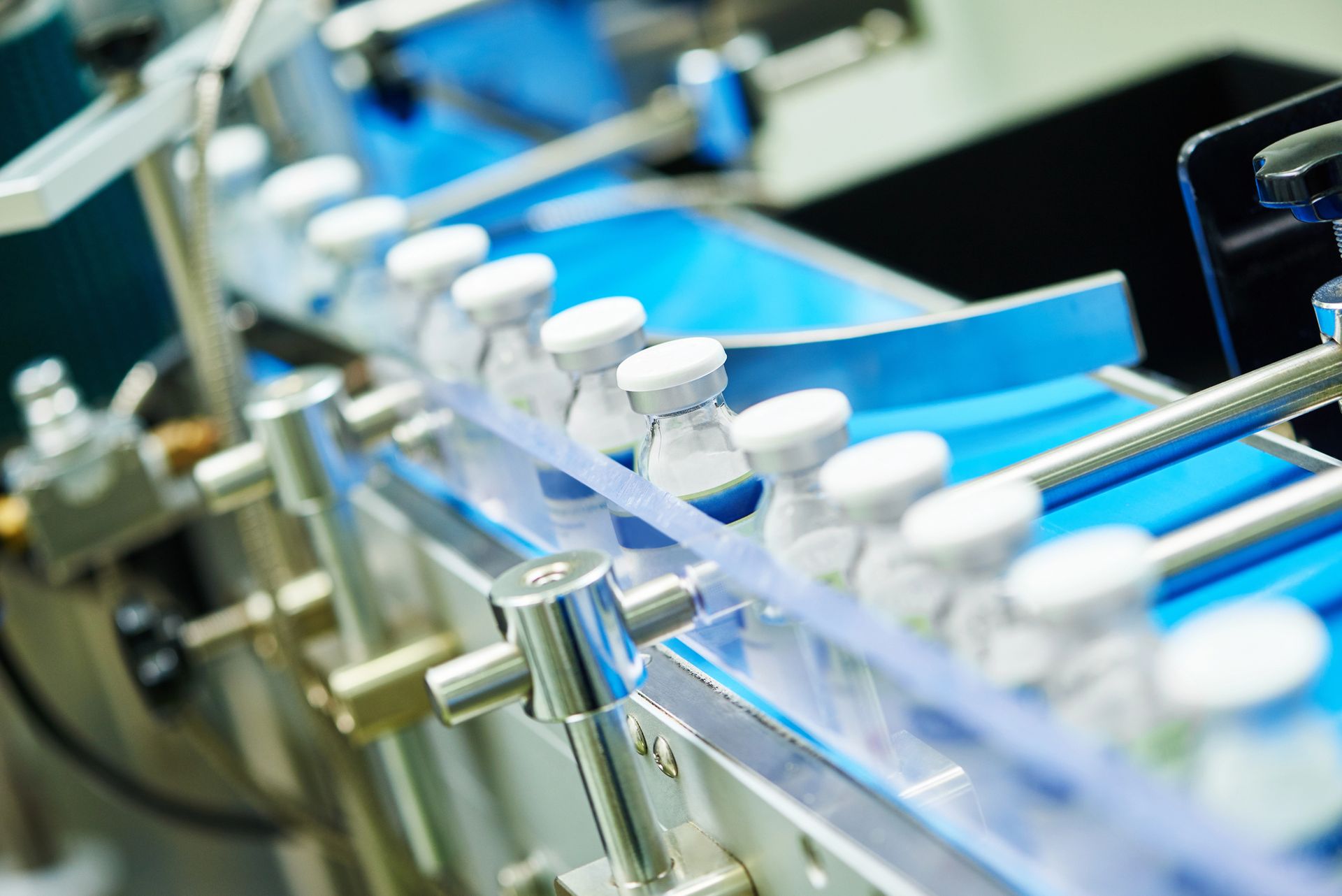Understanding cGMP: What Current Good Manufacturing Practices Are and Why They Matter
In the pharmaceutical, biotech, and food industries, ensuring that products are safe for consumption and effective in their intended use is critical to public health and trust. Current Good Manufacturing Practices (cGMP) are regulations enforced by various governing bodies to guarantee that companies adhere to rigorous standards throughout the manufacturing process.
cGMP guidelines cover every aspect of production, from facility design to staff training, equipment calibration, quality control, and record-keeping. These practices help prevent contamination and errors, safeguarding consumers from harmful products.
Read on to learn the meaning of cGMP, its essential components, and the importance of compliance for companies.

What Does cGMP Mean?
cGMP stands for current Good Manufacturing Practices. These are the latest guidelines and regulations that ensure manufacturers meet the highest safety, quality, and control standards in their production processes. The term "current" highlights the need to continually update and improve practices to align with new technologies and advancements.
While
GMP (Good Manufacturing Practices) refers to the foundational guidelines for manufacturing, cGMP emphasizes ongoing improvement and compliance with the most up-to-date standards. This helps companies follow general practices while integrating current methods and technology.
Industries Affected by cGMP
Adhering to cGMP guidelines can help companies comply with regulatory requirements, enhance their reputation, and improve consumer confidence in their products.
You will find cGMP throughout industries where product safety and quality are critical, such as:
- Pharmaceuticals: Certifies that medications are safe, effective, and manufactured consistently.
- Biologics: Governs the production of biological products like vaccines and gene therapies.
- Medical Devices: Ensures devices are safe for use and perform as intended.
- Food Manufacturing: Regulates food safety to prevent contamination and ensure consumer protection.
The Importance of cGMP in the Pharmaceutical and Biotech Industries
Current Good Manufacturing Practices set the framework for producing and controlling products to meet high standards, specifically concerning:
Product Safety and Efficacy
cGMP regulations help guarantee that products are produced and monitored under stringent quality controls. These standards help prevent contamination and production errors, minimizing the risk of mix-ups while upholding the integrity of pharmaceutical and biotech products.
Protecting Public Health
Complying with cGMP allows companies to safeguard public health by providing product purity and effectiveness. Violations of cGMP have led to product recalls and significant health risks, highlighting the importance of these standards in maintaining consumer safety.
Regulatory Compliance and Legal Repercussions
Regulatory bodies like the FDA and EMA enforce cGMP compliance, and failure to meet these standards can result in fines, product recalls, facility closures, and severe legal consequences.
Building Consumer Trust
Consistent adherence to cGMP fosters consumer confidence and bolsters brand reputation, giving companies a competitive advantage while ensuring public health and safety.
Core Components of cGMP
Personnel and training are fundamental elements of cGMP in pharmaceutical and biotech manufacturing. A well-structured training program and competent staff maintain high production standards and uphold product safety:
Component #1: Personnel and Training
A well-trained and qualified team is paramount when maintaining compliance and upholding manufacturing standards in any cGMP facility.
Qualified Personnel
A qualified team is the foundation of any cGMP-compliant facility. Employees must have the proper education, skills, and hands-on experience to perform tasks accurately and maintain strict manufacturing standards. In this context, qualified personnel must have the right degrees and practical experience specific to the functions they perform.
Continuous
cGMP training helps employees stay current with evolving regulations and best practices. Regulatory bodies, such as the FDA and Health Canada, expect companies to always maintain highly trained personnel. Companies must also keep track of their employees’ qualifications and provide regular updates, ensuring the team adapts to changes in processes or regulations.
An
example of compliance issuesdue to inadequately trained personnel occurred at Apotex, a large pharmaceutical manufacturer in Toronto. In 2014, Health Canada issued a warning to Apotex after an inspection revealed numerous cGMP violations. Among the concerns was insufficient staff training, which contributed to poor documentation practices and failure to meet quality control standards. This led to several product recalls and a temporary halt in exporting certain products to the U.S.
The violations highlighted the importance of maintaining a well-trained, qualified workforce to ensure compliance with Health Canada and
FDA regulations. Apotex had to invest in corrective measures, including improving employee training programs and enhancing its documentation systems, to restore compliance and avoid further regulatory actions.
Training Programs and Documentation
Training programs should cover various topics, from the fundamentals of cGMP to specific procedures based on the employee's role. They should be designed to guarantee that personnel understand the general requirements and the precise technical standards they must meet in their daily tasks.
Employees need refresher courses and regular training, especially when regulations change or new equipment is introduced. Training records must be well-maintained and detailed to show that employees are qualified to carry out their responsibilities. Regulatory agencies, like the FDA, often scrutinize these records during inspections. Poorly documented or incomplete training records can lead to warnings, penalties, or even production shutdowns.
A real-world example of the consequences of poorly documented training records comes from the
FDA's inspection of Ranbaxy Laboratories, a pharmaceutical company. During the inspection, the FDA discovered numerous GMP violations, including incomplete and inaccurate training records. This lack of proper documentation contributed to Ranbaxy receiving a warning letter from the FDA, facing import bans on several products, and eventually settling with the U.S. Department of Justice for $500 million.
This case highlights how inadequate record-keeping, especially with regard to training, can lead to severe regulatory actions including production halts and costly penalties.
Preventing Human Errors
Human error is a leading cause of cGMP violations, which makes employee training all the more critical. Properly trained staff can better recognize potential risks and avoid mistakes that could lead to contamination, incorrect labeling, or other production errors. For example, a lapse in understanding proper sterilization procedures could lead to contaminated products, resulting in costly recalls and legal liabilities.
Case studies show that the results can be disastrous when manufacturers lack adequate training. A well-known case involving insufficient training is
Johnson & Johnson's McNeil-PPC subsidiary, which faced major penalties due to non-compliance with
Good Manufacturing Practices.
These violations led to multiple product recalls for popular medications like Children's Tylenol, Motrin, and Benadryl. The root cause of these issues was inadequate training and oversight, which compromised product quality. As a result, the company entered into a consent decree with the FDA, requiring daily fines and extended regulatory supervision until corrective actions were completed.
Improved training, particularly in compliance and quality control, could have prevented these costly errors and protected the company's reputation.
Component #2: Facilities and Equipment
Strong facility design, regular equipment maintenance, and careful record-keeping are key to ensuring product quality and compliance in manufacturing:
Facility Design and Maintenance
Effective facility design helps prevent contamination and ensures easy cleaning and maintenance. Key elements include controlled environments, cleanrooms, and layouts that promote sanitary operations.
Prioritizing these features reduces the risk of contamination and ensures compliance with current Good Manufacturing Practices.
Equipment Calibration and Maintenance
Well-maintained and calibrated equipment produces consistent product quality. Regular maintenance ensures machinery operates at its best and meets cGMP standards. Investing in routine inspections helps minimize errors that could impact the final product.
Documentation and Record Keeping
Accurate, detailed records of equipment use, cleaning processes, maintenance activities, and other operational tasks supports traceability and accountability. These records help identify trends, improve communication, streamline decision-making, and maintain operational consistency.
By keeping thorough records, companies can quickly pinpoint and address potential issues, providing a detailed audit trail during inspections while staying compliant with regulatory standards.
Component #3: Production and Process Control
Strong production and process control relies on standardized operating procedures, in-process monitoring, and a structured approach to managing deviations:
Standard Operating Procedures (SOPs)
SOPs provide clear guidelines for employees, ensuring that all processes follow a consistent approach. Teams develop SOPs through collaboration among subject-matter experts, regularly reviewing and updating them to reflect current best practices and regulatory requirements. This process keeps procedures relevant and effective in maintaining high-quality standards.
Below is an example of an SOP for equipment cleaning:
A pharmaceutical company recognizes the need for a standardized cleaning procedure for its manufacturing equipment to prevent contamination and maintain product quality. To address this, the company initiates the following steps:
- Forms a cross-functional team: The company assembles a team of subject-matter experts, including quality assurance and engineering personnel, to collaborate on the SOP development.
- Drafts the SOP: The team researches current best practices in equipment cleaning, reviews industry guidelines, and gathers input from operators who perform daily cleaning tasks. They create a draft SOP that outlines step-by-step cleaning procedures, required cleaning agents, and safety precautions.
- Reviews and revises: The draft SOP undergoes multiple rounds of review. Team members provide feedback and make revisions to ensure clarity and comprehensiveness. They also check compliance with relevant regulatory requirements, such as cGMP standards.
- Training sessions: Once finalized, they distribute the SOPs to all relevant employees. The company offers training sessions to explain the new procedures and the importance of following them consistently.
- Implementation and monitoring: Employees begin using the SOP for equipment cleaning. Supervisors monitor compliance and gather feedback from staff on how well the procedure works.
- Regular Reviews and Updates: The team establishes a schedule for reviewing the SOP annually. They incorporate user feedback, best practice changes, and any updates to regulatory requirements to keep the SOP relevant.
In-Process Controls and Monitoring
Monitoring critical process parameters helps maintain product quality. In-process controls track crucial variables during production, allowing teams to make immediate adjustments when necessary. By closely tracking these parameters, facilities confirm that products meet quality specifications and regulatory standards.
Examples of these controls include:
- pH levels
- Temperature
- Mixing times
- Dissolved oxygen levels
- Conductivity
- Viscosity
- Flow rates
- Pressure levels
- Chemical concentrations
- Time intervals
- Sampling frequency
- Humidity levels
Deviation Management and Corrective Actions
A structured approach manages these issues to prevent product quality problems when deviations from standard procedures occur. Teams identify the root cause of each deviation and implement corrective and preventive actions (CAPA) to address and prevent future occurrences.
Component #4: Quality Control and Assurance
Here, we outline the elements of quality control, quality assurance, and change control to maintain product integrity:
Quality Control (QC)
Quality control focuses on testing and verifying the quality of raw materials, in-process materials, and finished products. It includes potency and sterility testing, ensuring products are free from harmful microorganisms. Stability testing evaluates how product quality changes over time, helping to determine shelf life and storage conditions.
Quality Assurance (QA)
Quality assurance ensures that the entire manufacturing process meets current cGMP standards. QA professionals audit, review, and approve procedures and records while overseeing product releases.
Their duties include approving SOPs and reviewing production and QC records to identify discrepancies before authorizing product distribution.
Change Control
Change control manages process modifications, equipment, and documentation to maintain product quality. A formal change control system evaluates the potential impact of proposed changes on quality and safety. This strategy typically involves gathering input from relevant stakeholders and maintaining detailed records of all changes.
Component #5 Documentation and Record Keeping
Enhanced documentation and record-keeping can help ensure compliance with cGMP standards:
Importance of Accurate Documentation
Accurate and complete documentation can include batch records, standard operating procedures, and deviation reports. These documents provide a transparent account of manufacturing processes and product quality.
Good Documentation Practices (GDP)
Good Documentation Practices (GDP) focus on accuracy, legibility, consistency, confidentiality, and timely completion. Adhering to these principles helps maintain reliable records that are critical for compliance. Poor documentation can lead to regulatory issues and product recalls, highlighting the need for high standards in record-keeping.
Electronic vs. Paper Records
Electronic records can streamline the documentation process and improve accessibility but pose data integrity and security risks. Implementing strong security measures in electronic systems can protect information and meet regulatory requirements.
Paper records offer a tangible format that some organizations find easier to manage. They can be straightforward and don’t require technical systems or software, making them accessible without digital tools. However, paper records are more prone to physical damage, loss, or deterioration over time.
The Role of cGMP in Continuous Improvement
cGMP helps organizations focus on continuous process improvement. Companies can maintain high standards and pinpoint improvement areas by conducting audits and creating feedback loops.
Advancements in technology, like automation and digitalization, boost cGMP compliance. These technologies streamline manufacturing and improve data management, leading to greater efficiency and fewer errors in production. For instance, automated systems can monitor process parameters in real-time, enabling quick adjustments to support product quality.
Encouraging employees to share their ideas and participate in identifying improvements can increase ownership and accountability. Engaged employees share insights that drive innovation and help organizations adapt to changes in processes or technologies.
How to Achieve and Maintain cGMP Compliance
Here’s a brief rundown on how to achieve and maintain cGMP compliance:
- Establish a Quality Management System (QMS): A robust QMS is vital for managing cGMP compliance. Key components include risk management, document control, and training.
- Provide regular training and education: Up-to-date training helps maintain compliance. Develop effective training programs tailored to employee needs.
- Perform internal audits and inspections: Regular audits identify and correct issues before regulatory inspections. Plan audits focusing on critical areas and avoid common pitfalls.
- Prepare for regulatory inspections: Prepare thoroughly for the FDA or EMA inspections. Present clear records, manage inspection teams, and respond to findings.
- Implement corrective and preventive actions: Address deviations promptly to prevent recurrence. Investigate issues, determine root causes, and implement corrective measures.
Common Challenges in cGMP Compliance and How to Overcome Them
Common challenges in achieving and maintaining cGMP compliance can pose significant obstacles, but strategies exist to overcome them. One major challenge is maintaining data integrity for electronic and paper records. Organizations can enhance accuracy and security by conducting regular audits and training on effective data management practices.
Another challenge involves managing change control. Issues often arise from resistance to change and inadequate documentation of modifications to processes or equipment. Organizations should implement a structured change control system to address these issues and involve relevant stakeholders to ensure buy-in.
Keeping up with regulatory changes presents a third challenge, as evolving regulations can complicate compliance efforts. Companies can achieve this by subscribing to regulatory updates, attending industry conferences, and participating in professional networks to share knowledge and insights.
Your Path to Compliance Starts with CfPIE
By investing in ongoing education with CfPIE, your organization can build a culture of quality and compliance. This commitment improves operational efficiency and product quality. With continuous training, your employees will gain the latest skills and knowledge, helping to create a proactive approach to compliance that reduces the risk of errors and violations.
Working with CfPIE equips your company to meet regulatory requirements and achieve lasting success in the pharmaceutical and biotechnology industries. As a leader in life sciences training, CfPIE can help you understand and implement cGMP standards effectively.
Ready to get started? Learn more about
our courses here.
Blog Categories
Stay Informed


